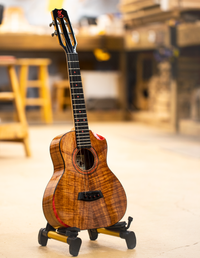
An instrument synonymous with Hawaiian culture, the ukulele originated from the machete de braga. In the 1870s, Portuguese sailors immigrated to Hawaii and introduced the machete de braga to locals, inspiring native cabinet makers to craft ukuleles. If you're interested in learning to play this famed instrument, review some beginner's information below.
Common Questions About Ukuleles
Is the instrument just a smaller guitar?
The ukulele shares similarities with classical acoustic guitars, including the shapes of their bodies and necks. However, the small instruments feature short scales on their necks and have four strings instead of six, which makes learning key changes easier for those starting. Also, while guitars offer accessories for musical experimentation, such as extensions and pedals, their smaller counterparts provide portability many people find attractive.
Which model is best if you’re learning to play?
 Available in soprano, concert, tenor, and baritone form, most people start with soprano ukeleles because of their smaller size. Soprano models are the Hawaiian standard, though some players prefer concert versions because their larger necks produce higher sounds, or tenors because of their versatility, including alternate tuning options. Since baritones are the largest options at 29 inches long, they often appeal to classical guitar players.
Available in soprano, concert, tenor, and baritone form, most people start with soprano ukeleles because of their smaller size. Soprano models are the Hawaiian standard, though some players prefer concert versions because their larger necks produce higher sounds, or tenors because of their versatility, including alternate tuning options. Since baritones are the largest options at 29 inches long, they often appeal to classical guitar players.
How do you hold the instrument?
The most comfortable hold depends on the instrument's size, as most people sit with tenor and baritone models. If you prefer to sit, rest the ukelele between your legs or balance it on one of your thighs. If you’d rather stand, hold it between your body and the forearm of your strumming hand, and use the underside of your non-strumming hand as extra support.
Add a strap if it makes you feel more comfortable, and never squeeze the instrument excessively to avoid interfering with wood vibrations and sound quality.
Can you reduce finger pain?
Finger pain is typical on your strumming hand, though calluses will eventually form to prevent further pain. To avoid discomfort as the skin thickens, practice for 10 to 15 minutes at a time daily to build up your tolerance. While playing the instrument has traditionally not involved picks, you also can use one if you want. Simply take care that you don't strum too vigorously to avoid damaging the instrument body.
Choose from the best variety of ukuleles at Kanile'a 'Ukulele. Located in Kaneohe, HI, this native- and family-owned music store manufactures custom instruments for clients around the world. Call (808) 234-2868 today with any more questions you have, or learn more about the company online. You can also like their Facebook page for the latest releases.
About the Business
Have a question? Ask the experts!
Send your question

